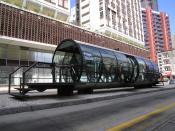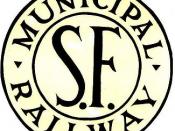Our school has a diverse student body, ranging everywhere from Guam to Texas. Many students are from areas that don't have buses, or that have busses, but run in only one direction and are easy to figure out. For the unfortunate majority of freshmen who didn't bring a car, the thought of riding a bus in San Francisco could be overwhelming or even scary. Using the San Francisco Municipal bus system is one of the easiest ways to travel the city after learning the rules, maps, times and fees.
The first step is to plan where you want to go within the city. You will need to decide the starting point, what day, and what time you want to travel. Then, pick up a copy of the Ride Guide map at any of the numerous outlets throughout the city. These outlets include libraries, city hall, chamber of commerce, and the Internet.
To understand how to plan your trip using the Ride Guide, follow these simple steps. On the route map, simply locate the beginning, and ending point of your bus trip. Locate the time point closest to your beginnings and ending bus trip location. A number inside a colored circle indicates time points on the route maps. Each time point on the route map has a corresponding column on the timetable. Not all bus stops are indicated on the map and there are many bus stops between each time point.
Find the column on the correct timetable that corresponds with your selected time point. Be sure you are using the timetable for the correct day of the week and direction of travel (inbound or outbound). Read down the column below the time point to find the time closest to your desired departure. Time for stops between time points can be estimated by adding the amount of time it will take the bus to get from the previous time point to your stop. In most instances, one route can serve your trip needs. On occasion, you may need to take more than one route to get to your destination.
Buses only stop at bus stop signs and booths located along the side of the street. Remember that the side of the street your on is important. For example, if you're on the left side of the street, the bus will be going in that direction. As the bus approaches, stand near the bus stop sign and signal to let the driver know you want the bus to stop for you. Do not expect to leisurely sit on the bench until a bus driver pulls up and opens the door for you. If you don't watch for the bus and walk to the sidewalk to make yourself visible, the bus might pass you by. When the bus stops at your stop, check the route number and destination on the electronic sign above the windshield or front door to make sure you are boarding the correct bus. The green busses are shuttle busses that will take you directly to the Golden Gate Bridge. Make sure you don't get on these buses unless you're planning to end up at the bridge.
It is vital that you have the exact cash fare, pass, ticket or transfers ready to give the driver when you board the bus. Operators or the fare boxes do not make change Remember being unprepared will hold up traffic onto the bus, and anger those waiting, so have your pass and exact change ready to give to the driver.
Once you have found your stop, prepared your fare and signaled to the driver, its time to board the bus. Once the bus has fully stopped board the bus nearest to the front. Wait for any people who might be exiting the bus. Often the person leaving by the front door is a senior or a person with a disability, so they may need an extra moment or two to descend the steps.
Once everyone has exited through the front doors its time to get on the bus. Quickly but catiously walk up the steps and put your $1.00 fare in the machine. Wait for the ticket to come out near the slot you put your money in. This small ticket is proof you have paid your fares. If you have a pass show the driver the pass and don't wait for a ticket.
Once you have paid its time to find a seat. Federal law mandates that the front seats of the bus are given up for seniors and persons with disabilities. Do not sit in those seats if a senior or person with a disability needs a seat. If no seats are available move to the back of the bus. If you have to stand, move as far as you can to the back of the vehicle. This will allow other passengers to board faster. If you leave by the rear, then the front door won't be clogged, slowing down the passengers coming on board. The only people who should leave from the front are seniors and people with disabilities, who are sitting in the front seats It's important to know that the bus driver will not be able to go back to the last stop if you missed it, so make sure you pay attention to the street signs out the window. Many drivers will call out or have a machine call out the upcoming streets. Many times the front of the bus will have a sign that will have the upcoming stops. Make sure you pay close attention to where you're at and where you're going.
As the bus approaches your stop, signal the driver by pulling down on the wire that is between the two windows. The pulling action will change the sign at the front of the bus. After you pulled the wire the sign at the front of the bus should read STOP REQUESTED in bold white letters with a red background. Be prepared to exit the doors immediately when the bus stops. It's requested that you exit through the back doors so that the elderly and disabled could get off in the front. When the bus stops, step down onto the last step to open the doors. The door will not automatically open when the bus stops, so it's important to step down on the step.
Riding the Muni bus in San Francisco is that easy. There should be nothing to worry about. If you paid attention to my easy steps on finding a map, finding the stop, finding a seat, and paying attention to the stops, you will be just fine navigating your way through San Francisco.





